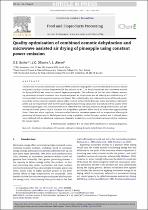 ResearchSpace
ResearchSpace
Quality optimisation of combined osmotic dehydration and microwave assisted air drying of pineapple using constant power emission
JavaScript is disabled for your browser. Some features of this site may not work without it.
- ResearchSpace
- →
- Research Publications/Outputs
- →
- Journal Articles
- →
- View Item
| dc.contributor.author |
Botha, GE

|
|
| dc.contributor.author |
Oliveira, JC

|
|
| dc.contributor.author |
Ahrné, L

|
|
| dc.date.accessioned | 2012-03-29T08:18:53Z | |
| dc.date.available | 2012-03-29T08:18:53Z | |
| dc.date.issued | 2012-04 | |
| dc.identifier.citation | Botha, GE, Oliviera, JC and Ahrne, L. 2012. Quality optimisation of combined osmotic dehydration and microwave assisted air drying of pineapple using constant power emission. Food and Bioproducts Processing, vol. 90(2), pp 171-179 | en_US |
| dc.identifier.issn | 0960-3085 | |
| dc.identifier.uri | http://www.sciencedirect.com/science/article/pii/S0960308511000137 | |
| dc.identifier.uri | http://hdl.handle.net/10204/5699 | |
| dc.description | Copyright: Published by Elsevier B.V. on behalf of The Institution of Chemical Engineers. This is the post-print version of the work. The definitive version is published in Food and Bioproducts Processing, vol. 90(2), pp 171-179 | en_US |
| dc.description.abstract | Combination of osmotic dehydration with microwave assisted air drying offers increased flexibility for process control and product quality. Osmotic dehydration (55ºBrix solution at 40ºC for 90 minutes) combined with microwave assisted air drying (MWAD) was tested on smooth cayenne pineapples. The influence of the four most relevant processing parameters (osmotic treatment time, microwave power, air temperature and air velocity) was studied using a 24 circumscribed central composite experimental design. The product quality was evaluated in terms of charred appearance at the surface, moisture content, soluble solids content, water activity, firmness, colour and volume. Microwave power and air temperature were the two most important processing parameters that influenced the quality of the dehydrated pineapple, with the parameters most affected by the operating conditions being water content and percentage of charred pieces. Only in the latter was a significant quadratic effect found, all others were approximately linear. There was also a significant interactive effect between microwave power and air temperature affecting the percentage of charred pieces. Model predictions using a quadratic surface for water content and % charred pieces were validated with an additional experiment. Quadratic models were used to indicate optimum drying conditions for various targets. | en_US |
| dc.language.iso | en | en_US |
| dc.publisher | Elsevier | en_US |
| dc.relation.ispartofseries | Workflow;4348 | |
| dc.subject | Combined technologies | en_US |
| dc.subject | Drying rate | en_US |
| dc.subject | Microwave drying | en_US |
| dc.subject | Osmotic dehydration | en_US |
| dc.subject | Overheating | en_US |
| dc.subject | Microwave energy | en_US |
| dc.subject | Pineapples | en_US |
| dc.subject | Constant power emission | en_US |
| dc.title | Quality optimisation of combined osmotic dehydration and microwave assisted air drying of pineapple using constant power emission | en_US |
| dc.type | Article | en_US |
| dc.identifier.apacitation | Botha, G., Oliveira, J., & Ahrné, L. (2012). Quality optimisation of combined osmotic dehydration and microwave assisted air drying of pineapple using constant power emission. http://hdl.handle.net/10204/5699 | en_ZA |
| dc.identifier.chicagocitation | Botha, GE, JC Oliveira, and L Ahrné "Quality optimisation of combined osmotic dehydration and microwave assisted air drying of pineapple using constant power emission." (2012) http://hdl.handle.net/10204/5699 | en_ZA |
| dc.identifier.vancouvercitation | Botha G, Oliveira J, Ahrné L. Quality optimisation of combined osmotic dehydration and microwave assisted air drying of pineapple using constant power emission. 2012; http://hdl.handle.net/10204/5699. | en_ZA |
| dc.identifier.ris | TY - Article AU - Botha, GE AU - Oliveira, JC AU - Ahrné, L AB - Combination of osmotic dehydration with microwave assisted air drying offers increased flexibility for process control and product quality. Osmotic dehydration (55ºBrix solution at 40ºC for 90 minutes) combined with microwave assisted air drying (MWAD) was tested on smooth cayenne pineapples. The influence of the four most relevant processing parameters (osmotic treatment time, microwave power, air temperature and air velocity) was studied using a 24 circumscribed central composite experimental design. The product quality was evaluated in terms of charred appearance at the surface, moisture content, soluble solids content, water activity, firmness, colour and volume. Microwave power and air temperature were the two most important processing parameters that influenced the quality of the dehydrated pineapple, with the parameters most affected by the operating conditions being water content and percentage of charred pieces. Only in the latter was a significant quadratic effect found, all others were approximately linear. There was also a significant interactive effect between microwave power and air temperature affecting the percentage of charred pieces. Model predictions using a quadratic surface for water content and % charred pieces were validated with an additional experiment. Quadratic models were used to indicate optimum drying conditions for various targets. DA - 2012-04 DB - ResearchSpace DP - CSIR KW - Combined technologies KW - Drying rate KW - Microwave drying KW - Osmotic dehydration KW - Overheating KW - Microwave energy KW - Pineapples KW - Constant power emission LK - https://researchspace.csir.co.za PY - 2012 SM - 0960-3085 T1 - Quality optimisation of combined osmotic dehydration and microwave assisted air drying of pineapple using constant power emission TI - Quality optimisation of combined osmotic dehydration and microwave assisted air drying of pineapple using constant power emission UR - http://hdl.handle.net/10204/5699 ER - | en_ZA |





